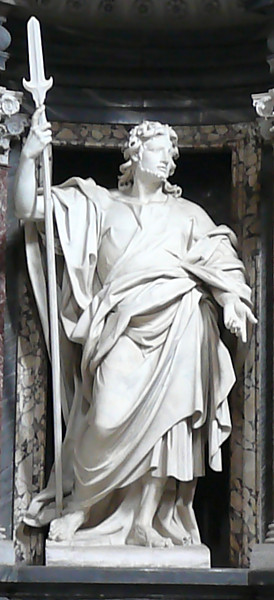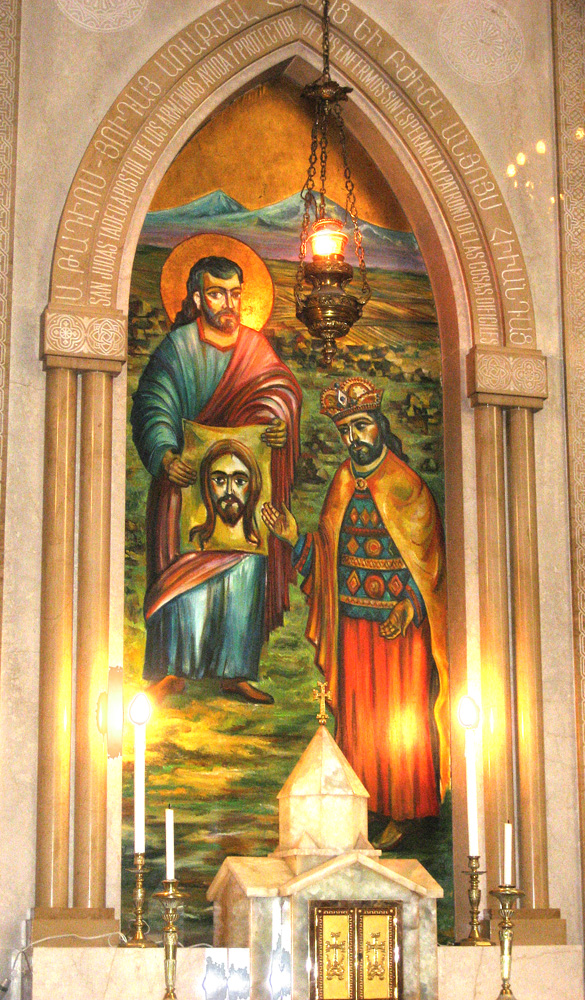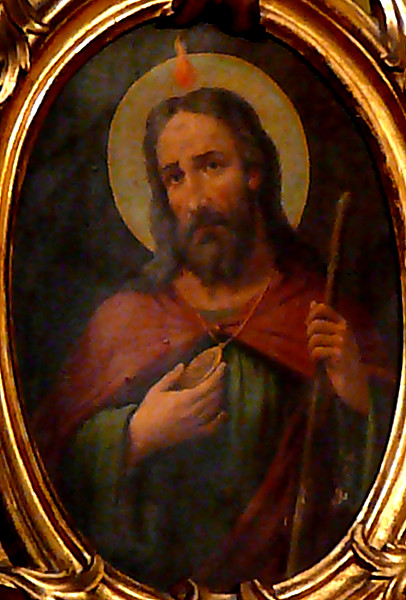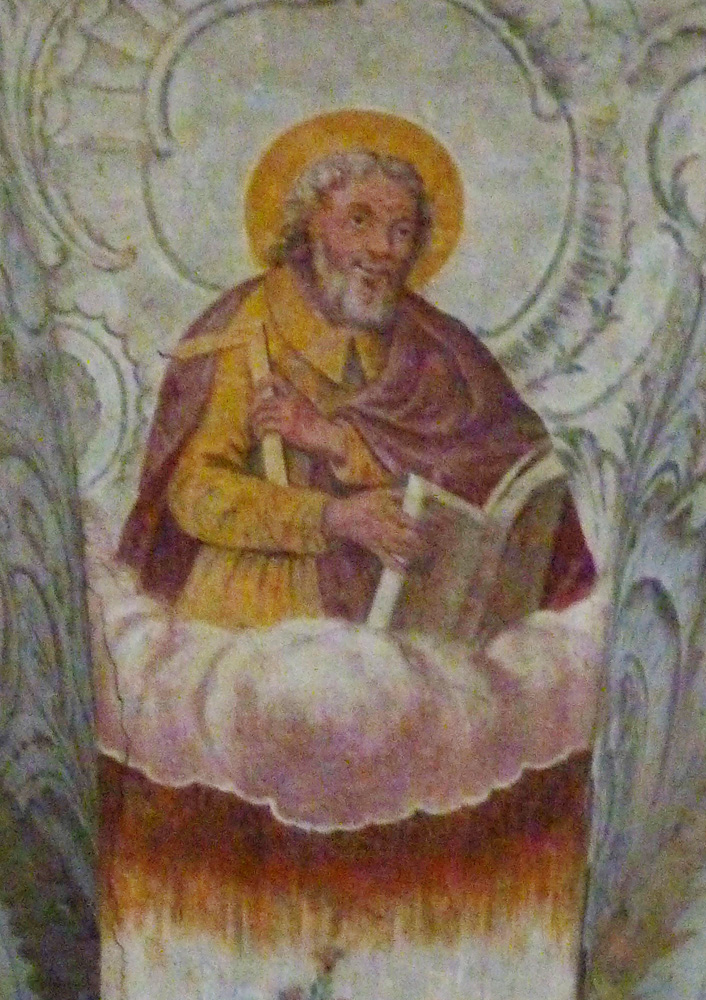1. HALBERD OR CLUB
As the Golden Legend tells it, Saints Simon and Jude were slain by pagan magicians enraged over the destruction of their idols. They ran upon the apostles and "hewed them to death."1. Lochner's painting shows the magicians doing the deed with broad swords, and one fresco in Germany uses a sword as Jude's attribute, but in all other images I have seen the attribute is either a halberd (as at right) or a club. In many cases the club is significantly broader at one end (example). The club or halberd could be related to the wand that the saint carries in a 5th-century fresco in St. Paul Outside the Walls.Unfortunately, the apostle James the Less has a fuller's club as his attribute, which can lead to confusion.
2. IMAGE OF JESUS
In the 5th-century fresco Jude also holds a white disk against his chest with some sort of picture on it. In the 6th or 7th century the Acts of Thaddaeus reports that Jesus made an image of his own face by wiping it on a cloth and sent it to King Abgar of Edessa, who had expressed his faith in him. There was already a story in Eusebius' 4th-century History of the Church that Jude visited Abgar after the Ascension, so it is no surprise that Jude came to be associated with the picture of Jesus. In the second picture on the right is a wall painting of Jude presenting the cloth to Abgar. In portraits the cloth may be used as an attribute (example). In later Latin Christianity there is an iconographic type in which St. Jude looks directly at the viewer while holding a plaque with Jesus' face up to his chest. (See the third picture on the right.)3. FLAME
In that western type of image a flame burns from the top of the saint's head. It might refer to the flames of which the Mesopotamian devils complain to Jude and Simon in the Golden Legend: "What will these apostles of the living God do to us? Lo! how we be burnt by flames in their entering into this city." Or it could reflect the fire imagery in the Epistle of Jude, where the author explains how to deal with "mockers": "some indeed reprove, being judged; but others save, pulling them out of the fire" (1:22-23).4. CARPENTER'S SQUARE
Perhaps owing to a confusion with St. Thomas, on rare occasions Jude carries a carpenter's square or calipers (as in the last picture on the right). There is nothing in the Golden Legend to suggest that Jude did any kind of carpentry.Prepared in 2014 by Richard Stracke, Emeritus Professor of English, Augusta University. Revised 2017-02-05, 2017-12-01.

1. St. Jude with a halberd: statue in the Lateran Cathedral, Rome (See the description page)

2. With Jesus' image (from an Orthodox church in Argentina – see the description page)

3. With flame and plaque (See the description page)

4. With a carpenter's square (See description page)
MORE IMAGES
- 12th century: Simon and Jude on contiguous columns in Oviedo's "Holy Chamber."
- 13th century (est.): The Apostles Window in Regensburg Cathedral, picturing the martyrdom of each Apostle.
- Circa 1753-62: This statue in Oviedo Cathedral is inscribed "S. JUDA" but seems to be using St. Bartholomew's iconography.
- 19th century: A statue at San Juan Capistrano, California.
- 19th century: New Mexico santo setting St. Jude among typical cacti of the U.S.'s desert southwest.
- Undated, Austria: Fresco in Weißpriach, cudgel broadened at one end.
- Undated, Germany: Statue with the cudgel.
DATES
- Feast day: October 28 in the West, June 19 in the East
NAMES
- St. Jude appears in the lists of apostles in Matthew 10:2-4 and Mark 3:16-19 under the name "Thaddeus," and as "Jude the brother of James" in Luke 6:16 and Acts 1:13.
- The King James translation of Matthew 10:2-4 calls him "Lebbaeus, who surname was Thaddaeus."
- In John 14:22 he is called "Judas…not the Iscariot."
- In medieval texts and images, the above names are assumed to belong to the same person and are used interchangeably.
- In Syrian Christianity Jude Thaddeus is "Addeus."
BIOGRAPHY
- Acts of Thaddaeus, in CCEL (Ante-Nicene Fathers, VIII)
- Golden Legend #159
- Eusebius, I, xiii
- Acta Sanctorum, October vol. 12, 450-467
NOTES
1 So Caxton. The Latin is eos protinus trucidarunt (Graesse 170). Ryan translates "killed them," which loses the sense of cutting that is intrinsic to the verb trucidare.